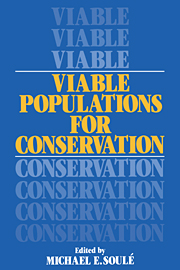Book contents
- Frontmatter
- Contents
- List of contributors
- Preface
- 1 Introduction
- 2 The demography of chance extinction
- 3 Extinction models and mammalian persistence
- 4 Minimum viable population size in the presence of catastrophes
- 5 Minimum viable populations: coping with uncertainty
- 6 Effective population size, genetic variation, and their use in population management
- 7 Spatial structure and population vulnerability
- 8 Managing critically endangered species: the Sumatran rhino as a case study
- 9 The role of interagency cooperation in managing for viable populations
- 10 Where do we go from here?
- Index
9 - The role of interagency cooperation in managing for viable populations
Published online by Cambridge University Press: 21 January 2010
- Frontmatter
- Contents
- List of contributors
- Preface
- 1 Introduction
- 2 The demography of chance extinction
- 3 Extinction models and mammalian persistence
- 4 Minimum viable population size in the presence of catastrophes
- 5 Minimum viable populations: coping with uncertainty
- 6 Effective population size, genetic variation, and their use in population management
- 7 Spatial structure and population vulnerability
- 8 Managing critically endangered species: the Sumatran rhino as a case study
- 9 The role of interagency cooperation in managing for viable populations
- 10 Where do we go from here?
- Index
Summary
The challenge of managing lands, resources, and people to sustain viable populations of large vertebrates and other taxa is enormous. Conservation biologists (e.g., Soulé, 1980; Frankel, 1983; 1984) have emphasized that few existing protected areas can provide this service for all desired species found within their bounds. However, most analyses of the ability of reserves to sustain viable populations (e.g., Soulé, 1980; Frankel and Soulé, 1981; Schonewald-Cox, 1983) consider each jurisdictional unit as a separate entity. This reflects a frequent lack of cooperation and the conflicting priorities and management practices that can exist in adjacent areas (Schonewald-Cox and Bayless, in press; Harris, 1984). The future of many species would not be nearly as bleak if managers who share species of concern would cooperate to minimize conflicts and reach mutual conservation goals.
The effectiveness of cooperation in attaining conservation goals has been demonstrated by The Nature Conservancy since its inception in 1951 (Jenkins, 1984). More recently, the value of cooperation was recognized in the first recommendation of the Terrestrial Animal Species Panel at the US Strategy Conference on Biological Diversity (US Dept. of State, 1982): ‘… identify, establish, and manage a worldwide system of national parks and other conservation areas to insure the perpetuation of all major ecosystem types and the diversity of organisms and processes they contain … in a way which promotes local economic development compatible with long-term ecosystem integrity and the sustained use of natural resources.’
- Type
- Chapter
- Information
- Viable Populations for Conservation , pp. 159 - 174Publisher: Cambridge University PressPrint publication year: 1987
- 19
- Cited by



